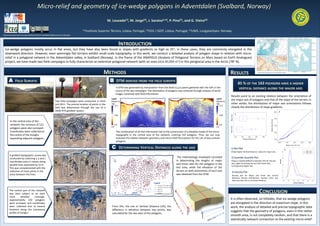Micro-relief and polygon geometry
- 1. Micro-relief and geometry of ice-wedge polygons in Adventdalen (Svalbard, Norway) M. Lousada(1), M. Jorge(2), J. Saraiva(1,3), P. Pina(1), and G. Vieira(2) (1)Instituto Superior T¨¦cnico, Lisboa, Portugal, (2)CEG / IGOT, Lisboa, Portugal, (3)UNIS, Longyearbyen, Norway Research developed within the project ANAPOLIS (PTDC/CTE-SPA/099041/2008),funded by FCT (Portugal) INTRODUCTION Ice-wedge polygons mostly occur in flat areas, but they have also been found in slopes with gradients as high as 25ˇă; in these cases, they are commonly elongated in the downward direction. However, even seemingly flat terrains exhibit small-scale topography; in this work, we conduct a detailed analysis of polygon shape in relation with micro- relief in a polygonal network in the Adventdalen valley, in Svalbard (Norway). In the frame of the ANAPOLIS (Analysis of Polygonal Terrains on Mars based on Earth Analogues) project, we have made two field campaigns to fully characterize an extensive polygonal network (with an area circa 40,000 m2) in this periglacial area in the Arctic (78ˇă N). METHODS RESULTS Adventdalen Topographic map and ESRI Base Maps A FIELD SURVEYS B DTM DERIVED FROM THE FIELD SURVEYS 85 % OF THE 163 POLYGONS HAVE A HIGHER A DTM was generated by interpolation from the 8166 (x,y,z) points gathered with the GPS in the VERTICAL DISTANCE ALONG THE MAJOR AXIS course of the two campaigns. The delineation of polygons was achieved through analysis of aerial images combined with field information. Results point to an existing relation between the orientation of Two field campaigns were conducted, in 2010 the major axis of polygons and that of the slope of the terrain; in and 2011. The precise location of points in the other words, the distribution of major axis orientations follows field was determined through the use of a closely the distribution of slope gradients. GNSS-RTK geodetic system. 2 1 In the central area of the network, the contours of 121 polygons were also surveyed. Coordinates were collected at The combination of all that information led to the construction of a detailed model of the micro- the centre of the troughs topography in the central area of the network, covering 163 polygons. Thus, we can now separating adjacent polygons. evaluate the relation between geometry and micro-relief fluctuations for this set of low-centred polygons. C DETERMINING VERTICAL DISTANCES ALONG THE AXIS 1) Box Plot 3 Shows higher Vertical Distance values for major axis. A gridded topographic survey was conducted by collecting x, y and z The methodology employed consisted 2) Quantile-Quantile Plot coordinates every 5 meters along in determining the lengths of major Shows a marked difference between VDs for the two and minor axes for the polygons in the axes, again illustrating the fact that major axes parallel lines separated by 10 m. correspond to higher VDs This was complemented with the test area, while the elevation of the collection of more points in the terrain on both extremities of each axis 3) Density Plot areas between the lines. was obtained from the DTM. Density plot for Major and minor axis vertical distances density distributions. Several minor axis have less then 20 cm of vertical distance. The central part of the network was later subject to an even CONCLUSION more detailed coverage. Approximately 150 polygons It is often observed, on hillsides, that ice-wedge polygons were surveyed, and coordinates are elongated in the direction of maximum slope. In this were collected also at several From this, the rise or Vertical Distance (VD), the work, the analysis of detailed and precise topographic data locations along the transversal difference in elevation between two points, was profile of troughs. suggests that the geometry of polygons, even in this rather calculated for the two axes of the polygons. smooth area, is not completely random, and that there is a statistically relevant connection to the existing micro-relief .

